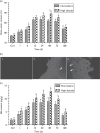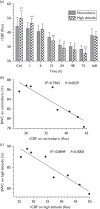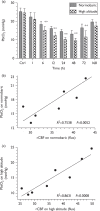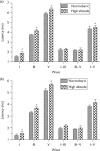Characteristics of a rat model of an open craniocerebral injury at simulated high altitude
- PMID: 25191925
- PMCID: PMC4222709
- DOI: 10.1097/WNR.0000000000000259
Characteristics of a rat model of an open craniocerebral injury at simulated high altitude
Abstract
To establish a rat model of an open craniocerebral injury at simulated high altitude and to examine the characteristics of this model. Rats were divided randomly into a normobaric group and a high-altitude group and their corresponding control groups. A rat model of an open craniocerebral injury was established with a nail gun shot. Simulated high-altitude conditions were established with a hypobaric chamber at 0.6 ATA to mimic pressure at an altitude of 4000 m. Mortality, brain water content (BWC), Evans blue content, pathology, regional cerebral blood flow (rCBF), partial pressure of brain tissue oxygen (PbtO2), and brainstem auditory-evoked potential were observed after injury. The mortality of the high-altitude group was significantly greater than that of the normobaric group within 72 h after injury (P<0.05). BWC and Evans blue content increased by 48 h after injury (P<0.05); pathological changes in damaged brains were more serious. In contrast, rCBF and PbtO2 had decreased markedly by 72 h (P<0.01); brainstem auditory-evoked potential values were significantly prolonged (P<0.05). Moreover, an inverse correlation between rCBF and BWC and a positive correlation between rCBF and PbtO2 were found. The rat model of an open craniocerebral injury at simulated high altitude can be established successfully using a nail gun shot and a hypobaric chamber. The injury characteristics at high altitude were more serious, rapid, and prolonged than those in the normobaric group.
Figures






Similar articles
-
Establishment of an experimental rat model of high altitude cerebral edema by hypobaric hypoxia combined with temperature fluctuation.Brain Res Bull. 2020 Dec;165:253-262. doi: 10.1016/j.brainresbull.2020.10.017. Epub 2020 Oct 24. Brain Res Bull. 2020. PMID: 33141074
-
Brain hypoxia is exacerbated in hypobaria during aeromedical evacuation in swine with traumatic brain injury.J Trauma Acute Care Surg. 2016 Jul;81(1):101-7. doi: 10.1097/TA.0000000000001048. J Trauma Acute Care Surg. 2016. PMID: 26998778
-
Amelioration of rCBF and PbtO2 following TBI at high altitude by hyperbaric oxygen pre-conditioning.Neurol Res. 2010 Mar;32(2):173-8. doi: 10.1179/174313209X414524. Neurol Res. 2010. PMID: 20158955
-
Nail gun injuries to the head with minimal neurological consequences: a case series.J Med Case Rep. 2016 Mar 16;10:58. doi: 10.1186/s13256-016-0839-1. J Med Case Rep. 2016. PMID: 27080512 Free PMC article. Review.
-
[Advance in animal models of traumatic brain injury].Fa Yi Xue Za Zhi. 2011 Aug;27(4):286-9, 294. Fa Yi Xue Za Zhi. 2011. PMID: 21913561 Review. Chinese.
Cited by
-
Neuroinflammation aggravated by traumatic brain injury at high altitude is reversed by L-serine via NFAT1-mediated microglial polarization.Front Cell Neurosci. 2023 Apr 14;17:1152392. doi: 10.3389/fncel.2023.1152392. eCollection 2023. Front Cell Neurosci. 2023. PMID: 37124395 Free PMC article.
-
Interorgan communication in neurogenic heterotopic ossification: the role of brain-derived extracellular vesicles.Bone Res. 2024 Feb 22;12(1):11. doi: 10.1038/s41413-023-00310-8. Bone Res. 2024. PMID: 38383487 Free PMC article.
-
Hemoglobin Concentration May Affect the Effect of Atorvastin on Chronic Subdural Hematoma After Burr-Hole Drainage at High Altitude.Front Neurosci. 2020 Jun 12;14:503. doi: 10.3389/fnins.2020.00503. eCollection 2020. Front Neurosci. 2020. PMID: 32595442 Free PMC article.
-
The effect of hematoma puncture drainage before decompressive craniectomy on the prognosis of hypertensive intracerebral hemorrhage with cerebral hernia at a high altitude.Chin J Traumatol. 2021 Nov;24(6):328-332. doi: 10.1016/j.cjtee.2021.08.006. Epub 2021 Aug 12. Chin J Traumatol. 2021. PMID: 34511323 Free PMC article.
-
The Effect of Hemoglobin Concentration on Hyperbaric Oxygen and Non-hyperbaric Oxygen in the Treatment of Hypertensive Intracerebral Hemorrhage After Operation at the High Altitude.Front Hum Neurosci. 2022 Jun 30;16:834427. doi: 10.3389/fnhum.2022.834427. eCollection 2022. Front Hum Neurosci. 2022. PMID: 35845240 Free PMC article.
References
-
- Weisbrod AB, Rodriguez C, Bell R, Neal C, Armonda R, Dorlac W, et al. Long-term outcomes of combat casualties sustaining penetrating traumatic brain injury. J Trauma Acute Care Surg 2012; 73:1525–1530. - PubMed
-
- Hoge CW, McGurk D, Thomas JL, Cox AL, Engel CC, Castro CA. Mild traumatic brain injury in U.S. soldiers returning from Iraq. N Engl J Med 2008; 358:453–463. - PubMed
-
- Defense and Veterans Brain Injury Center http://www.dvbic.org/TBI-numbers. [Accessed 25 June 2012].
Publication types
MeSH terms
LinkOut - more resources
Full Text Sources
Other Literature Sources
Research Materials

